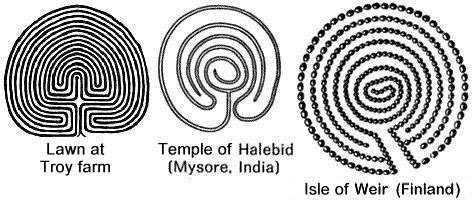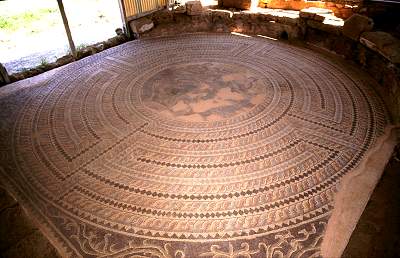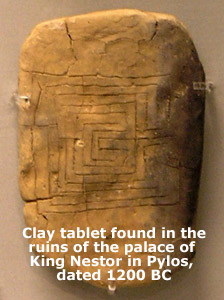
by Gary Vey for Viewzone
In The Wizzard of Oz, Dorothy begins her journey to the magical kingdom of Oz by stepping on a spiral path, paved in yellow bricks. The spiral moves outward and eventually forms a straight and wide road, along which she meets and befriends her partners on their quest.
Although the journey to Oz ended with success, it was a one way street. The yellow brick road never doubled back on itself once it reached the Emerald City. Because of that, the yellow brick road can not really be viewed as a labyrinth.
A true labyrinth is a single path that reaches a central point, then continues to retrace its way back to the beginning. A labyrinth is often mistaken for a maze, which has many "false" paths, and the two structures have very different origins and purposes. The labyrinth's purpose is to resolve conflict while the maze is designed to confuse.

There are two basic types of labyrinths. The classic form, also called the Cretan labyrinth, has seven connected paths. It is connected to the following legend which also describes the creation of a classic maze:
Ariadne was the daughter of King Minos of Crete. Minos had Daedalus build a Labyrinth, a house of winding passages, to house the bull-man, the Minotaur, the beast that his wife Pasiphae bore after having intercourse with a bull. (Minos had refused to sacrifice a bull to Poseidon, as the king promised, so the god took revenge by causing his wife to desire the bull--but that's another story.) Minos required tribute from Athens in the form of young men and women to be sacrificed to the Minotaur.Theseus, an Athenian, volunteered to accompany one of these groups of victims to deliver his country from the tribute to Minos. Ariadne fell in love with Theseus and gave him a thread which he let unwind through the Labyrinth so that he was able to kill the Minotaur and find his way back out again.
Ovid says that Daedalus built a house in which he confused the usual passages and deceived the eye with a conflicting maze of various wandering paths (in errorem variarum ambage viarum) (Metamorphoses 8.161):
"so Daedalus made the innumerable paths of deception [innumeras errore vias], and he was barely able to return to the entrance: so deceptive was the house [tanta est fallacia tecti]" (8.166-68).
The second type of "cathedral labyrinth" can be seen in old churches. In 1200, as the Cathedral of Chartres was being built, a large labyrinth was set with in the floor with dark blue and white stones. Similar labyrinths were placed in other French Gothic cathedrals, such as Amiens, Saint-Quentin, Rheims, Sens, Arras and Auxerre. By the 18th century, all of these labyrinths, except the ones at Chartres and Saint-Quentin, were suppressed. The labyrinth at Amiens was later restored in 1894.

These cathedral labyrinths were all laid out in the same pattern. They were formed by 11 concentric circles that contained a single path which slowly leads to a center rosette. The path makes 28 loops, seven on the left side toward the center, then seven on the right side toward the center, followed by seven on the left side toward the outside, and finally seven on the right side toward the outside, ending in a short straight path to the rosette.
During the Middle Ages, people made pilgrimages to these great churches instead of going to Jerusalem. It became the custom to walk the labyrinth to the center and then retrace the path out of the labyrinth. This "walking the labyrinth" was seen as a spiritual event. By walking the labyrinth, the faithful traced the path of a long and difficult life on earth, beginning with birth, at the entrance, and ending with death, at the center. The way out symbolized the fact or hope that a well lived life continued in either heaven or purgatory.
I was curious why a geometric shape, traditionally associated with a pagan culture, would be found in a prominent Christian church. Was this really something spiritual?



This unique shape has been perpetuated in many human cultures. Labyrinths are found carved in rock, ceramics, clay tablets, mosaics, manuscripts, stone patterns, turf, hedges, and cathedral pavements. The earliest known designs are about 3000 years old. What can they really mean?


Since the design originates in the human mind and has persisted over thousands of years, it must tell us something about how the human mind functions. It must also serve some purpose associated with the function of the brain.
In a previous article on viewzone, Left Brain: Right Brain, I showed how the human mind is a cooperative or joint effort between two distinct brains: our left and right hemispheres. Accidents and surgical procedures have occasionally damaged the only link connecting these two bodies, the corpus collosum, and the results demonstrated that each hemisphere functions independent of the other.
 Further research reveals that each hemisphere understands the world in vastly different ways. While the left brain is concerned with logic, details and facts, the right brain is based on feelings, emotions and imagination. Our personality is determined and moulded by which brain, left or right, we allow to be dominant in resolving problems and making decisions in our daily life.
Further research reveals that each hemisphere understands the world in vastly different ways. While the left brain is concerned with logic, details and facts, the right brain is based on feelings, emotions and imagination. Our personality is determined and moulded by which brain, left or right, we allow to be dominant in resolving problems and making decisions in our daily life.
This view of a "two brained" mind has produced a new model of mental illness seen as a struggle for dominance by each brain. Therapies seeks to lessen the conflicts between opposite parts of our brain and coax them to work together in peace and harmony.
An analogy is given of a group of workers who have different ideas about solving a problem. They must somehow be made to trust each other and cooperate. This is typically achieved in a business by some form of "team building" workshops, such as corporate boot camps or by having a shared experience like white water rafting.
I think the labyrinth is just such an exercise in "team building" between the left and right brains, forcing them to cooperate on a task in which they must both learn to trust and compromise. In this way, it may indeed be therapeutic.

In the classic labyrinth there is left-right and right-left movement combined with boredom, future planning, goal attainment and repetition. Each element forces the two brains to cooperate on a mental as well as physical level. If some problem is contemplated while performing the labyrinth, it is possible that logic and emotional compromises will likewise be mediated.
 According to one Labyrinth society, tracing the path of the labyrinth achieves spiritual and emotional calmness in three stages:
According to one Labyrinth society, tracing the path of the labyrinth achieves spiritual and emotional calmness in three stages:
- The first os called "Purgation" where one is supposed to release the details of life and shed thoughts of distractions. This, according to the two-brain theory, would relax control from the left brain.
- The second stage is called "illumination" which is reached when the center of the labyrinth is achieved. This is said to relax the right brain which is normally anxious to imagine and reach the goal.
- The last stage is called "union" where the labyrinth path is re-traced to the beginning, allowing both brains to cooperate in a relaxed state.
There is yet another example of how the labyrinth is linked to brain function -- music. It is believed that ancient labyrinth "walks" were actually danced to some sort of music or rhythm. Music is also a product of our human mind. Like the classical labyrinth, music has seven segments or tones, and like the labyrinth, music often has two phases which complete the cycle.
I asked music professor Anthony Brandt of Rice University about this phenomenon in music theory. His reply follows:
What I believe you are describing is the harmonic structure of tonal music. In classical harmony, the tonic is the chord that represents maximum order, stability and clarity: It is the "answer." The question is posed by the "dominant," a chord that is unstable (the "question") and must ultimately resolve to the tonic. Music of the "common practice era" (from Bach to Brahms) is built out of the opposition between dominant and tonic, or the alternation of "tension and release," as it is often described. Keep in mind that, in 20th/21st-century concert music, this opposition may no longer be maintained.
"Tension and release" is a very human phenomenon associated with everything from exercise to orgasm. It's no surprise then that this pattern has become an archetype of our life, death and hope for rebirth. The labyrinth provides a temporary psychic escape from the normal reality and allows one to experience all of the adventure of a true pilgrimage. We begin the journey not knowing what to expect, yet the goal is ever present in our mind. The journey is long and often repetitious, sometimes boring. Although the goal is reached, it is not the end of the journey. Finally, the path leading home is familiar and triumphant.
It is thought by some people that the Nazca lines and the many images of animals in Peru were actually paths walked or danced by ancient people in religious rituals. Perhaps the belief was that the power or essence of the depicted animal would be gained by this effort.

Repeatedly walking left and right might actually be healthy for our brains, especially when combined with music.
 Rhythm Therapy was discovered and developed by jazz drummer, Ronnie Gardiner, an American musician who has lived and performed in Scandinavia for over thirty years. Gardiner conceived the idea over twenty years ago as a result of a tragic loss and a personal crisis. The foundation, structure, and all the different sequences that comprise the evolved form of Rhythm Therapy were developed since then, in between his busy musical engagements, and has been used to help stroke victims recover their mental capacities.
Rhythm Therapy was discovered and developed by jazz drummer, Ronnie Gardiner, an American musician who has lived and performed in Scandinavia for over thirty years. Gardiner conceived the idea over twenty years ago as a result of a tragic loss and a personal crisis. The foundation, structure, and all the different sequences that comprise the evolved form of Rhythm Therapy were developed since then, in between his busy musical engagements, and has been used to help stroke victims recover their mental capacities.
In short, this type of therapy combines physical movements of the left and right side of the body with musical rhythms, much like dancing. Alternating signs in red and blue, representing the left and right arms and legs, are shown to patients who learn to move the corresponding body part. This "dance" is repeated to a musical rhythm and the neural pathways, damaged from a stroke, began to mend and "re-set."
This seems to show that there is something deeper going on with music, dance and "walking the labyrinth." It is something that has been felt by the ancients but not entirely understood. "Understanding" is a left brain function while "feeling" is right brain function. Which is more important? You decide.
Comments:
The pictures of the labyrinths on your website are all vaguely reminiscent of pictures of the naked human brain, a picture of which is also on your website. This is true even down to the hemispheric division that occurs in many of the labyrinths you have displayed. It’s possible that they modeled them after the brain, and they may have believed that completing the circuit would somehow alter or improve brain function or bring enlightenment. Then again, maybe they just had way too much free time on their hands.
Jon H Benson

